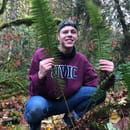She has abandoned the plane altogether. After wreaking beauty and havoc in her Los Angeles magnum opus Norman Fucking Rockwell, Del Rey has expressed concern and worry about “however [Norman’s] younger sister turns out,” referring of course to her newest album, Chemtrails Over the Country Club.
Chemtrails is a departure in many ways for Del Rey’s character. In it, she rediscovers her roots, but only at a great cost.
The release of her debut studio album Born To Die in 2012 saw the inception of Lana Del Rey’s roman-a-clef, the name and persona that would come to be one of “America’s greatest living songwriters,” according to Pitchfork magazine (ironically, the same publication that called her debut album “the sonical equivalent of a fake orgasm”). Before this catapult to fame, Del Rey was going by her birth name, Elizabeth “Lizzy” Grant, performing shows and creating songs at a much smaller scale. Lizzy Grant dreamt of fame and fortunes, but it’s only once she got everything she wanted that she wished she could take it all back.
Now a decade down the line, with six major studio albums and a book of poetry under her belt, Del Rey remains a prominent force in the music industry and the culture itself, being completely complicit in glorifying Americana whilst lamenting the failure of it. And within it, the mission of finding and knowing her true self. Creating the image of Lana Del Rey required a sacrifice of Lizzy Grant’s character, and now being on the precipice of another grand chapter of her illustrious and widely publicized life, Chemtrails warns of an even bigger sacrifice: the name of Lana Del Rey herself.
This loss has been foreshadowed not only in Norman’s track “The greatest” but throughout her entire decade-long career.
Coming in at 11 tracks total, Chemtrails is Del Rey’s shortest album but remains a large step, or stray, forward for her role as a musician, artist, singer, and above all, writer.
- “White Dress”
-
If there is a singular word to describe the opener, it is awestruck. Harnessing delicate and heartbreaking vocals, Del Rey takes the listener back a decade. She details her days as a “waitress wearing a white dress,” listening to Kings of Leon and the White Stripes without a care in the world when she was “only nineteen.” Young Del Rey is truly a nobody but feels as if she has it all as she waitresses, rollerblades, and flirts with the “men down at the music business conference.” “It made me feel like a God,” she sings with the utmost sincerity in her trembling voice. According to Del Rey in “White Dress,” she was at her best back then, and she’s at her best singing about it now, even after losing it all.
- “Chemtrails Over The Country Club”
-
And then the world of Chemtrails Over The Country Club begins with its title track. The album is a journey that spans several states, timelines, and dimensions. “There are seven worlds, I’m accessing them all at once,” Del Rey mentions in her poetry book Violet Bent Backwards Over the Grass (a crucial precursor to the narrative of Chemtrails). The album — and titular song — starts in full blast, with Del Rey “drag racing her little red sports car” while she’s on the run, Thelma and Louise-style. It feels like a homecoming of sorts after the jarring introduction of “White Dress”: she’s returned to her usual register of singing that her fans know and love. The song is pure Lana Del Rey, with her fully embracing her identity through her astrological chart. “My cancer is sun and my leo is moon,” she croons.
- “Tulsa Jesus Freak”
-
If Chemtrails is indeed Norman’s sister, “Tulsa Jesus Freak” is the obvious “Cinnamon Girl” of the album, begging to blow out car speakers and climb charts. The first stop on Del Rey’s map of escapism is Tulsa, Oklahoma, before contemplating, “go[ing] back to [the neighbouring] Arkansas.” She’s neither here nor there; she’s everywhere, between state borders and states of mind.
- “Let Me Love You Like A Woman”
-
“80 miles north or south will do.” Locale has always been a theme of Del Rey’s, with her lovers representing the cities that she’s lived in. If Ultraviolence was the quintessential New York album and Lust For Life / Norman Fucking Rockwell the Los Angeles albums, Chemtrails is all the space in between, all the country roads and small towns. “Let Me Love You Like A Woman” is the thesis statement of Chemtrails, serving as the first single. It’s a simple song, but goes a long way.
- “Wild At Heart”
-
“Wild At Heart” is the explosive, angry, mid-album-climax of Chemtrails. In the song, she’s walked through the destruction of what she’s created in the coda of Norman’s “the greatest,” wherein she metaphorically brings apocalyptic ruin upon Los Angeles. And now, being on the run, she’s near the clear, or out of the fire, at least. She’s gone primal. “I left Calabasas, escaped all the ashes, ran into the dark,” she sings with a wolflike ferocity in her voice. It all alludes to a sacrifice that she needs to make to pay the price of freedom. Freedom is, in Del Rey’s case, losing her stardom and fame. She even questions disappearing entirely from the public eye. “What would you do if I wouldn’t sing for them no more?” she warns.
- “Dark But Just A Game”
-
Turns out, she was just kidding. As she always is. But Del Rey prods the stick of truth deeper into the skin. This track is a pivotal point in Chemtrails as Del Rey sings “the best ones lost their minds / So I’m not gonna change / I’ll stay the same.” She could never lose herself, but dreaming and contemplating about it is a dangerous thing to do. She alleviates the pain by singing the title of track six: “It’s dark, but just a game.” The track is an elegant trip down the rabbit hole, sounding like something out of a James Bond theme song.
- “Not All Who Wander Are Lost”
-
“Not All Who Wander Are Lost” is the glimmering, Disney-princess garden song of the album. But instead of a white dress fit for a princess, she’s clad in “the same damn clothes” that she’s been wearing for “three damn days.” Being on the run has morphed her into a nobody, unrecognizable. But the Tolkien-esque title is perhaps the most crucial component, or mantra, to the puzzle of Chemtrails. While she may be on the run, she’s not lost. “It’s just wanderlust,” she bargains.
- “Yosemite”
-
This song was first mentioned during the release of Del Rey’s fourth studio album, Lust For Life. It was scrapped at the last minute because she felt that the song was simply too uplifting. In an interview for Lust For Life, Del Rey specifies in regards to the song “we’re not there yet.” Now in the dark of Chemtrails, “Yosemite” is a shining beacon of hope for Del Rey: a place of pure nature, wanderlust, and beauty.
- “Breaking Up Slowly”
-
Nikki Lane, who has sung with Del Rey during her time abroad, sings in unison a sweet song about a relationship gradually burning out over time, as the title obviously states. It’s a cute song but not as meaningful as earlier songs, narratively. However, it does lend to the sly country-music tone of the album, working towards an overarching theme. With Lane’s shared vocals and writing, it’s “The Other Woman” of Chemtrails.
- “Dance Until We Die”
-
Two more women are introduced in the next song, “Dance Until We Die.” Del Rey sings “I’ve been covering Joni and dancing with Joan,” both foreshadowing the finale and the things she’s done to get there. In November of 2020, celebrating the victory of President Joe Biden and vice-president Kamala Harris, Del Rey posted on her Instagram a video of Joan Baez dancing in the aisles of a supermarket, captioning “man that’s my girl – she never stops dancing!” “Dance Until We Die” is an adequate penultimate song for the album with an excellent bridge to go with it: “Joan said she was gonna quit / Tearin’ it up at the Afro-Caribbean two-step.” Even Fleetwood Mac’s Stevie Nicks looms from afar: “Stevie’s calling on the telephone.” With all these women around her who have accepted her into the pantheon of folk music, Del Rey expresses her gratitude. “God, it feels good not to be alone.”
- “For Free”
-
Chemtrails comes full circle with a cover of Joni Mitchell’s 1969 song “For Free”. It depicts a musician on a corner playing music for free, and hints at Del Rey’s gradual quest for freedom. Enlisting singers Zella Day and Weyes Blood to the song and the girl-group roster of Chemtrails, Del Rey has successfully built and executed another dimension of her psyche. The incorporation of these secondary characters builds a world of shared perspectives, women who have found themselves down the same rabbit hole as Del Rey. It adds to the overarching allure of the album, even to the cover art depicting Del Rey surrounded by ten of her close friends in a black-and-white image that is eerily reminiscent of the final group shot of Stanley Kubrick’s The Shining, both celebratory and ominous.
With the conclusion of Chemtrails, it seems as if Del Rey has found that elusive freedom, or a version of it that will keep her alive, at least. She’s got her friends with her, and she may disappear forever, but at last Lana Del Rey might be free.
But what does that say for her nineteen-year-old Elizabeth “Lizzy” Grant self? With “White Dress,” Del Rey contemplates a desire to go back in time to another lifetime where she never got her destructive fame. Chemtrails Over the Country Club may just be her desperate, heartbreaking, beautiful farewell.



